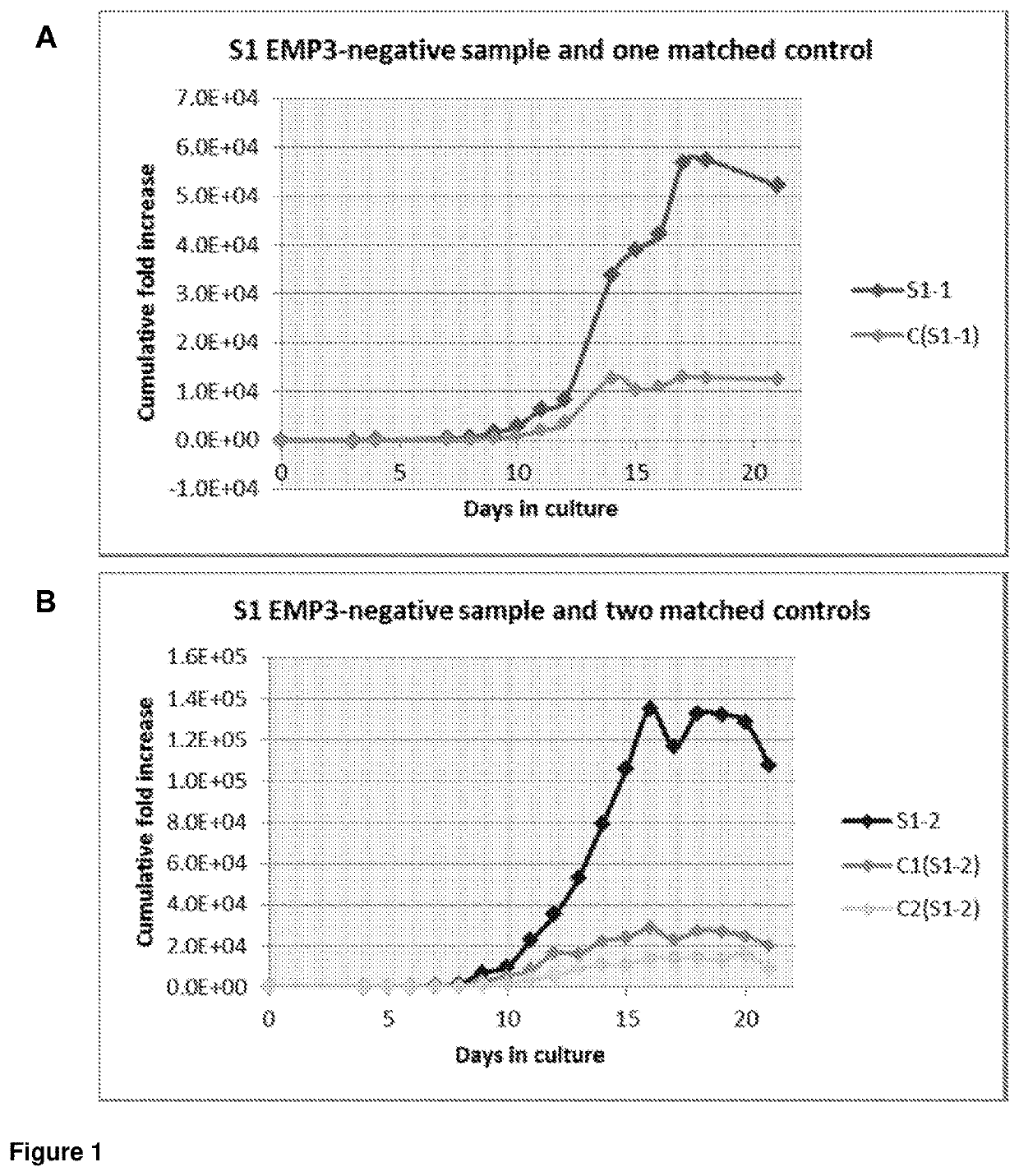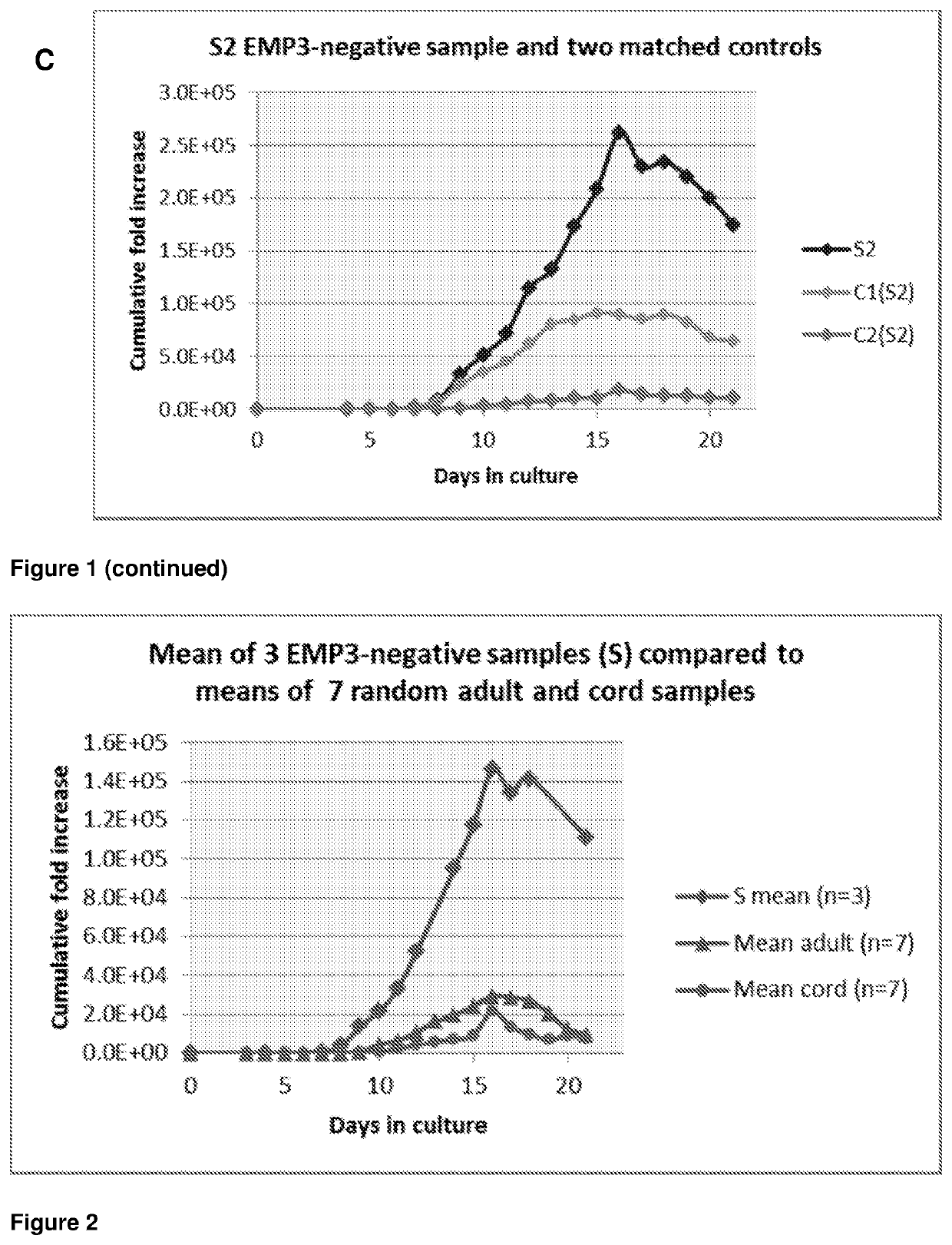Method for Producing Erthyroid Cells
a technology of erythroid cells and erythroid cells, which is applied in the field of methods for producing erythroid cells, can solve the problems of not producing economically viable quantities of erythroid cells needed for therapeutic or diagnostic use, has, however, always been limited, and cannot meet the needs of whole blood blood supply, etc., and achieves the effect of reducing the expression of emp3 and greater yield of erythroid cells
- Summary
- Abstract
- Description
- Claims
- Application Information
AI Technical Summary
Benefits of technology
Problems solved by technology
Method used
Image
Examples
example 1
ation of EMP3-Negative Individuals
[0125]Nine EMP3-negative individuals were initially investigated by serology due to pregnancy and anti-EMP3 production. Whole-exome sequencing was used to identify the lack of EMP3 candidate gene and then inactivating mutations were demonstrated in ten known EMP3-negative individuals.
example 2
Hematopoietic Cells from EMP3-Negative Individuals
[0126]Hematopoietic progenitor CD34+ cells from the peripheral blood of two EMP3-negative individuals and five age and gender matched EMP3-positive individuals were cultured and compared in three independent experiments.
[0127]CD34+ cells were obtained either from whole blood units or buffy coats and isolated by positive selection with the MiniMACS magnetic bead system (Miltenyi Biotec, Bisley, UK). The cells were cultured following the three-stage culture protocol with Iscove's modified Dulbecco's medium (Biochrom IMDM, Source BioScience, Nottingham, UK) supplemented with the following cytokines: 10 μg / mL recombinant human (rH) stem cell factor, 1 μg / mL rH interleukin 3 (R&D Systems Europe, Abingdon, UK), 3 IU / mL erythropoietin (Roche Products, Welwyn Garden City, UK), human transferrin 200 μg / mL (R&D Systems). Cells were cultured at 0.5 to 1×105 / mL in 5% CO2 at 37° C. Cell proliferation was recorded daily and aliquots were removed d...
example 3
EMP3 Gene in Immortalised Erythroid Cell Line
[0132]A BEL-A2 immortalised erythroid cell line was generated in the same manner as the BEL-A cell line (described in Trakarnsanga, K. et al 2017. Nature communications, 8, p. 14750). Adult bone marrow CD34+ cells were transduced with an HPV16-E6 / E7 construct and maintained in primary medium for 4 days. On day 5 cells were transferred to expression media containing doxycycline to induce expression of E6 and E7 and maintained in the same medium thereafter.
[0133]The BEL-A2 immortalised erythroid cell line was utilised as a model for silencing the EMP3 gene. Native BEL-A2 was confirmed to express EMP3 by confocal microscopy and flow cytometry. Initially, targeted shRNA lentiviral transduction was used to knock-down the expression of EMP3. Lentiviral vector was produced in HEK293T cells (Takara Bio Europe, Paris, France), which were seeded at 8×106 per flask prior to transfection with 15 μg psPAX2 (packaging plasmid), 5 μg pMDG2 (envelope pla...
PUM
| Property | Measurement | Unit |
|---|---|---|
| concentrations | aaaaa | aaaaa |
| doubling time | aaaaa | aaaaa |
| doubling time | aaaaa | aaaaa |
Abstract
Description
Claims
Application Information
 Login to View More
Login to View More - R&D
- Intellectual Property
- Life Sciences
- Materials
- Tech Scout
- Unparalleled Data Quality
- Higher Quality Content
- 60% Fewer Hallucinations
Browse by: Latest US Patents, China's latest patents, Technical Efficacy Thesaurus, Application Domain, Technology Topic, Popular Technical Reports.
© 2025 PatSnap. All rights reserved.Legal|Privacy policy|Modern Slavery Act Transparency Statement|Sitemap|About US| Contact US: help@patsnap.com



